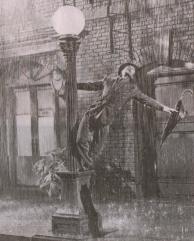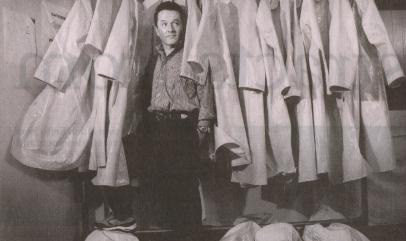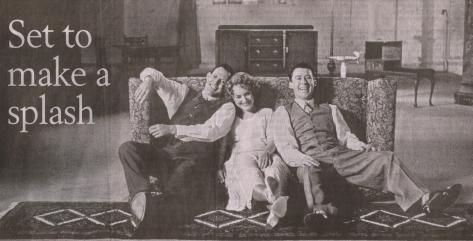
Todd McKenney is singing in the rain. In 2500 litres of rain that's heated in two huge tanks. It's filtered and recycled, and then dropped on him eight times a week. It took months to work out how to make this happen, but it had to be done. It would be unthinkable to mount a theatrical production of the classic movie Singin' in the Rain without the star performing the title song soaking wet, in a plausible downpour.
It was non-negotiable, says the show's producer, director and choreographer David Atkins. He couldn't imagine the song being performed in any way other than Gene Kelly's rendition on film, with a joyous surrender to the elements, splashing and stamping in puddles, and getting soaked to the skin.
But there were all kinds of practical obstacles to getting a torrential amount of water into the theatre. There were electrical problems: how to cope with splashing the pit when the orchestra had electrical instruments and how to find a waterproof radio microphone for McKenney. And finally, how to make transparent rain visible to the audience. In the movie, milk was added to the rain but that wasn't possible for the stage, "because it would clog up the filters. And because water splashes on the audience, too, the health risks are really high. The water in our tanks is cleaner than tap water and it's tested twice a week." On stage, special lighting was used to achieve the desired effect.
There were a couple of other essential elements for the show: some famous dance numbers, particularly the frantic acrobatic solo Make 'Em Laugh, performed by Donald O'Connor, had to mimic the original film versions. Make 'Em Laugh took three days to film: on stage, Wayne Scott Kermond performs it live, eight times a week. "It's a killer routine," Atkins says. "It's the thing we started at rehearsals on the first day and we worked on it every day for six weeks ... and it's a showstopper."
He has returned frequently to the original film orchestrations. But he has kept a song, What's Wrong With Me?, that was added to their stage adaptation by the screenplay writers Betty Comden and Adolph Green. Some of his own additions are made for staging reasons -- a couple of new dance routines function as bridging scenes and add to the spectacle at key moments.
"You also need more coherence on stage," Atkins says. "It's harder for audiences to make logical jumps. They're more used to filling in gaps at the movies."
Stage productions might demand more explanations but they can also take more time to add depth to a character or to extend comic routines -- so in Singin' in the Rain there's the chance to give the two, contrasting female leads a greater impact and to inject more humour. Eagle-eyed fans of the film will spot both similarities and differences, and perhaps they'll notice Atkins' fleeting homage to Gene Kelly -- a rose -- that's a reference to the Kelly musical An American in Paris.
Stage shows based on films are not new and three of Broadway's biggest current hits -- The Producers, The Lion King and The Full Monty -- started out on the small screen. But Singin' in the Rain is a special case: it's a movie about movies, steeped in Hollywood lore, full of in-jokes and references to the film industry.
It is set in 1927 at the end of the silent film era and it was filmed in 1952, at a time when American cinema was being threatened by television.
In the film, Gene Kelly is a movie actor and Jean Hagen is his formidable leading lady. Donald O'Connor is his best friend, a pianist who plays on set, and Debbie Reynolds plays an aspiring actress who meets Kelly's character under awkward circumstances.
Their lives are changed when sound comes to Hollywood. The studio Kelly works for, Monumental Pictures, has to move with the times and make a talking picture.
Chaos ensues, as everyone grapples with the new medium -- particularly Hagen's character, Lina Lamont, whose Tweety Pie-meets-fingernails-down-a-blackboard voice isn't ideal for playing aristocratic French heroines.
Critic Gerald Mast, the author of Can't Help Singin', a history of the American musical, declared Singin' in the Rain "could never be as interesting as a stage musical" because "it is so much about the practices and procedures of film making". Its first manifestation as a stage show in the mid-1980s, choreographed and directed by the celebrated choreographer Twyla Tharp, did nothing to change Mast's mind.
For David Atkins, there might be logistical problems in creating a theatrical version of a movie-centred film and in staging moments that have intensely cinematic qualities, but he says the constraints of live performance are also the key to success. Seeing live performance, with all its risks, is what audiences will come for.
"The show reconfirms the strength of the individual on stage. There are four great performances" -- the production stars Todd McKenney, Wayne Scott Kermond, Rachael Beck and Jackie Love -- "and that's what people will take away with them. They love the rain, of course -- that's what they talk about at the interval. But at the end they come out talking about the performances."
But the nature of performance is not a matter Atkins takes for granted.
He acquired the rights to Singin' in the Rain three years ago (along with rights to the film choreography by Kelly and Stanley Donen), but delayed the production because of his work as the artistic director of the opening and closing ceremonies of the Olympics.
Now, he says the time is right for doing the show -- "but it's probably something you wouldn't look at doing in another two or three years". If the movie is about a moment of crisis in Hollywood cinema, that was made at the time of a second crisis, then this stage version comes at an interesting time. The film, Atkins says, "is one of the all-time great musicals and nothing's going to change that.
"But on stage, it's hard to know. I wonder how the stage is going to be perceived and how it will be viable in the coming decade." He feels the period of theatre as spectacle is coming to an end: "Now people will look for contemporary ways of using the medium."
Atkins has just aquired the rights to "a very contemporary Broadway production" -- but can't say what it is.
Singin' in the Rain considers -- and has enormous fun with -- the nature of celebrity and performance, and the way cinema creates, employs and sustains illusions, in everything from movie fanzines to sound effects. But within the film there are all kinds of delicious twists concerning the nature of deception: Debbie Reynolds, for example, plays a character who dubs another performer's voice in the new talkies, but her singing voice was dubbed in a couple of numbers.
There are similar, pleasing anomalies to be found in presenting a live show whose story is all about deception -- and using theatrical illusions to create a world of cinematic ones. Although he's happy to talk about staging and effects, Atkins says people aren't particularly interested in mechanics, preferring to surrender to a sense of wonder. It's not like the cinema, he says. "Everyone seems to know how movie special effects work, but the theatre has been better at keeping its secrets."Singin' in the Rain is in preview: opening night is at the Regent Theatre on Friday.


Gene Kelly in the original film and David Atkins amongst the bright yellow raincoats worn by the cast.


